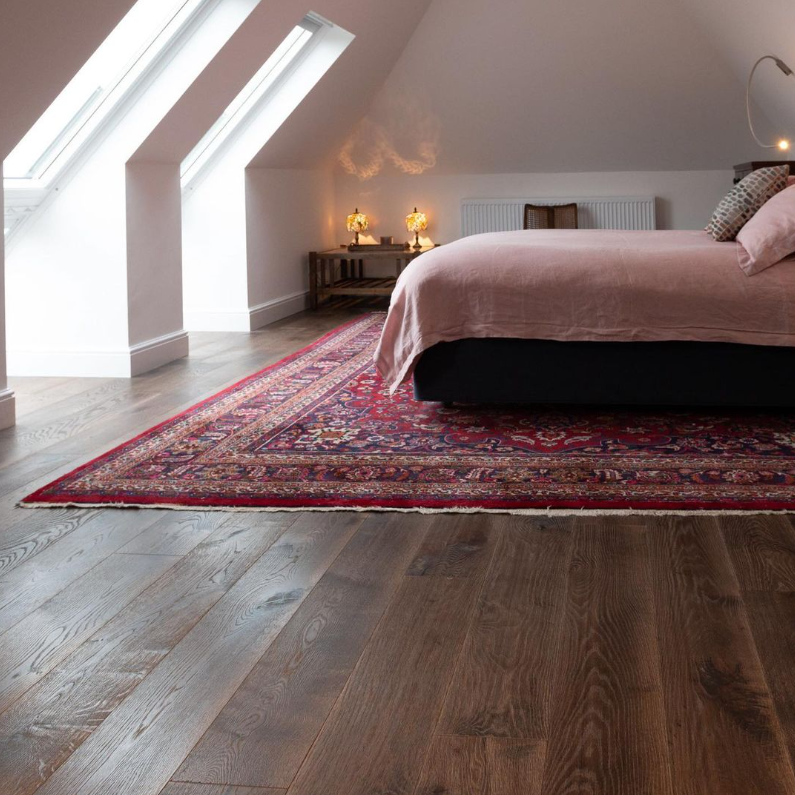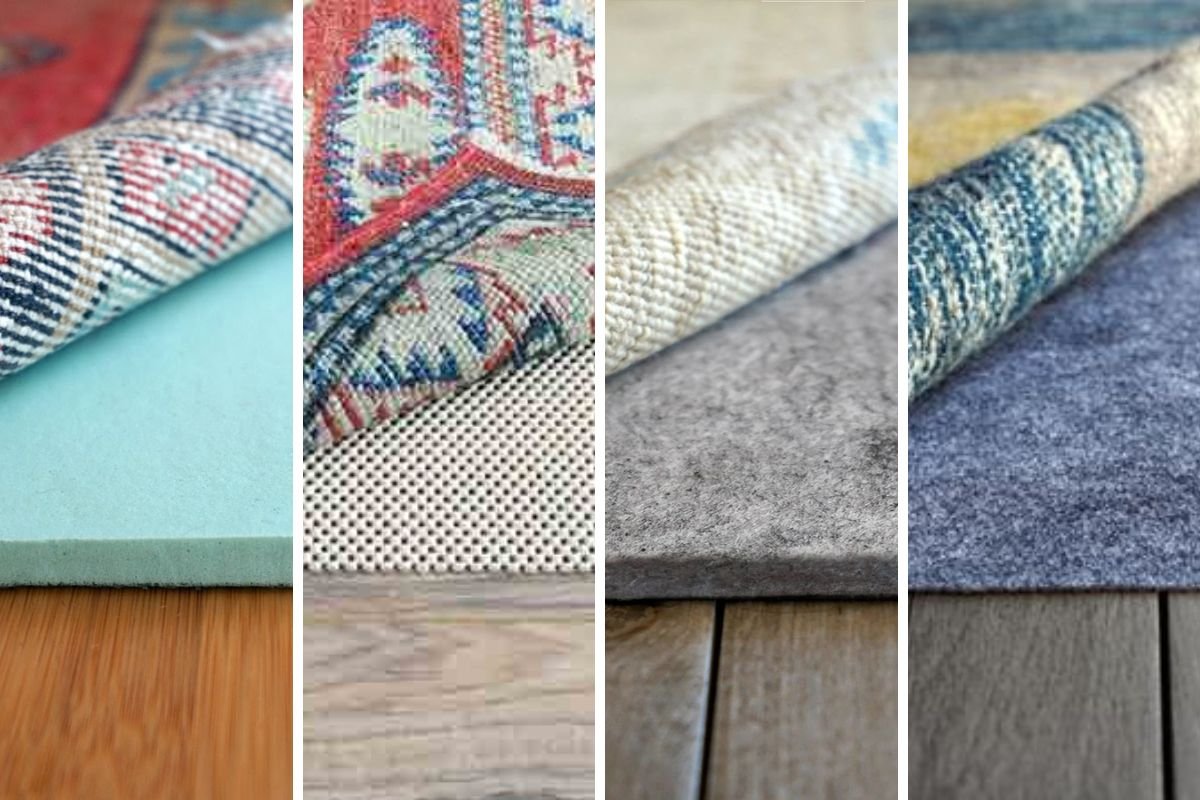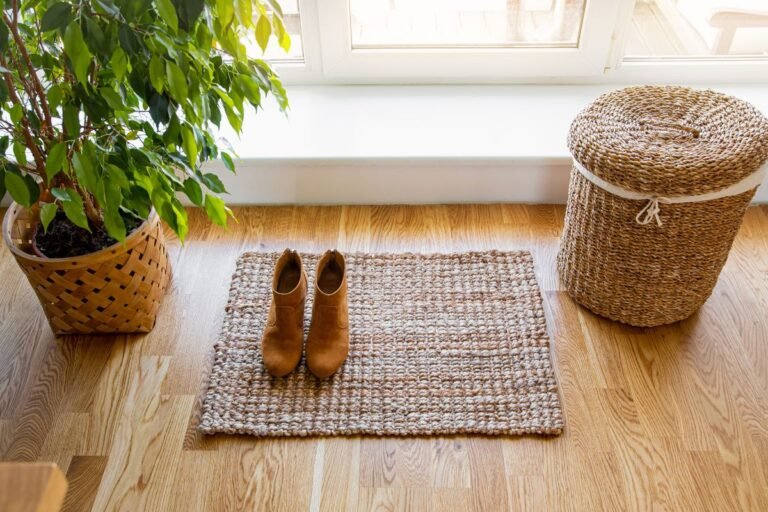Whether you want a cushioned rug pad or you want something to keep your low profile area rugs in place, rug pad thickness matters.
It’s not too difficult to find the right rug pad size, I’ll help you do that now.
Finding the right rug pad thickness for your area rug comes down to just a few factors. Let’s go through them now.
How Thick Should A Rug Pad Be?
In most cases, a rug pad should be at least 1/4 inch thick. But thickness may vary depending on the specific needs and usage of the area rug. When choosing a rug pad, it’s important to consider the size, weight, and placement of the area rug, as well as the level of foot traffic in the area.
For instance, you wouldn’t want to place a thick rug pad under a doorway, would you? Likewise, you wouldn’t want to put a plush rug pad under thin or flatweave rugs for fear they’d swivel atop the memory foam too!
Rug pads vary greatly, so to help you focus, let’s get a few things straight.
Generally speaking, these are the considerations when choosing a rug pad thickness:
- Is it a high traffic area or low traffic?
- Is it a high pile rug or low pile rug?
- Is it a large rug, which tends to be heavy, or a small and lightweight rug that can slip around easily?
- Will this be in an area that could potentially cause a tripping hazard?
I’ll go through all of this now so that you can find the exact right rug pad thickness for your home!

Materials For Rug Pads And How They Perform
When it comes to choosing a rug pad, the material you select can greatly impact its performance and general rug pad thickness. There are several options to consider, including PVC, felt, rubber, and a combination of felt and rubber.
Each of these materials has its own benefits and drawbacks:
- PVC rug pads are generally more affordable, but they may cause issues with certain types of floors, such as vinyl or hardwood, due to the chemicals in the plastic.
- Felt rug pads are great for providing extra cushioning and support, but they do not grip floors unless combined with a natural rubber backing. Pure felt pads are best for heavier area rugs that are not likely to slip or bunch.
- Natural* rubber rug pads are thin and sticky, making them best for a non slip rug pad. It is ideal for smaller rugs where the primary function is to keep the rug in place. *Natural rubber does not damage floors but is not recommended for vinyl flooring.
- A combination of felt and rubber can offer the benefits of both materials, with felt providing cushioning and protection and rubber providing grip. If you want a thick rug pad with non slip grip, then a felt and rubber pad is the best option for you.
It’s important to carefully consider the specific needs and usage of your rug when choosing a rug pad to ensure you get the best option for your needs.
| Rug Pad | Non-Slip | Waterproof | Cushion | Eco-Friendly | Low Profile | Safe For All Floor Types* |
| Dual Surface | ✔️ | ✔️ | ✔️ | |||
| Super-Lock Natural | ✔️ | ✔️ | ✔️ | ✔️ | ||
| RugPro | ✔️ | ✔️ | ||||
| Eco-Plush | ✔️ | ✔️ | ||||
| Cloud Comfort Memory Foam | ✔️ | ✔️ | ||||
| Nature’s Grip | ✔️ | ✔️ | ✔️ | ✔️ | ||
| Superior-Lock | ✔️ | ✔️ | ✔️ | ✔️ | ||
| Contour-Lock | ✔️ | ✔️ | ✔️ | ✔️ |
What To Know About Thick Rug Pads vs Thin Rug Pads
When it comes to selecting a rug pad, you have the option of either a thick or thin pad. There are a few important considerations when committing to thick pads or thin pads, which I’ll go over here.

Thick Rug Pads
There are a few reasons why you might want a thick rug pad. Thicker pads not only make a home or space more cozy, but they also provide a lot of protection and insulation. Here are the main benefits of thicker pads:
- Extra cushioning for comfort and rug protection
- Protects floors from wear and tear, spills, and furniture scratches
- Soundproofing your home
- Provides insulation for warmth on hard floors
Recommended Thick Rug Pad Material
There are several materials that are commonly used for thick rug pads, including:
- Memory foam: Memory foam rug pads are made of a dense, spongy material that conforms to the shape of your feet and provides good cushioning and support. They are generally thicker than other types of rug pads and may be a good option for large area rugs or for people with foot or joint pain.
- Felt: Felt rug pads are made of dense, compressed fibers and are a good choice for rugs placed on hard surfaces such as wood or tile. Thick felt pads provide good cushioning and sound absorption.
- Felt and rubber: When searching for a rug pad that offers both comfort and stability, a felt and rubber combination may be an excellent choice. This type of material is robust and reliable, making it ideal for areas with heavy foot traffic. It is also suitable for use on hardwood floors, as it helps to prevent scratches and scuffs. The thick and durable construction of a felt and rubber rug pad can provide the necessary support and protection for your floors and rugs.
When choosing a thick rug pad, it’s important to consider the specific needs and usage of the rug and the type of floor it will be placed on.
When To Use Thick Rug Pads
There are certain circumstances where it may be necessary to use a thicker rug pad. For example:
- If you have heavy furniture that could potentially damage your rug or floor, then a thick rug pad made of materials such as felt or memory foam can help absorb the weight and protect your surfaces.
- A plush and durable felt rug pad may be necessary for larger, high pile rugs like Persian or Oriental rugs to provide lift and support without damaging the rug.
- A thicker rug pad can be beneficial for homes with children or for those who want a more comfortable sitting area, as it can provide extra cushioning.
- If you live in an apartment and are concerned about noise from above, a soundproofing rug pad can help absorb footfall and reduce noise transmission.
Thin Rug Pads
Thin rug pads are better for high traffic areas and under thin area rugs. They are usually more affordable compared to thick rug pads too. They’re also easier to vacuum, which can be a pretty significant factor to consider for busy households!
Recommended Thin Rug Pad Material
There are several materials that are commonly used for thin rug pads, including the following:
- Natural rubber: Rubber pads grip floors really well and so are ideal for thinner pads that need to keep small rugs in place. Many rug pads either have a natural rubber backing or are coated in natural rubber, like with jute rug pads.
- Jute: Jute rug pads are made from a natural plant fiber and are thin, lightweight, and affordable. They provide a moderate level of cushioning and grip, and are a good choice for use with thin rugs. However, jute rug pads may not be as durable as some other materials and may not provide as much grip as rubber or foam pads.
- Felt: Felt rug pads are made from natural fibers and provide a soft, cushioned surface for area rugs. They are also thin and easy to cut to size. However, felt rug pads may not be as durable as some other materials and may not provide as much grip as rubber or foam pads.
When To Use Thin Rug Pads
There are certain situations in which a thicker rug pad might not be the best choice. For example, you’ll want a thin rug pad if:
- You have a flat weave or smaller area rug, you may want to opt for a rug pad with a natural grip rather than a thicker one. A non-slip rug pad with a rubber backing can help keep your area rug in place and prevent slips on slippery surfaces.
- You have a medium-size or larger area rug in a high-traffic area, a thinner rug pad is a better option. This is because a slim but durable rug pad can protect your floors and prevent your rug from slipping, especially near frequently used doors.
- You have a lighter rug, a low-profile felt-rubber rug pad may be a good choice to provide protection for your floors while preventing your area rug from sliding around.
How To Factor In The Area Rug Pile
The thickness of the rug pad you choose is for sure influenced by the height of the pile on your area rug. If your area rug has a high pile, then a thicker rug pad to keep it in place and protect the floor underneath. An area rug with a lower pile may not need as much cushioning and support, so a thinner rug pad may be sufficient.
Here are my recommended rug pads for each rug size.
Thin And Flat Weave Rugs (1/4″ or Lower Pile Height)
If you have a thin or flat weave area rug, it may tend to move around or become misshapen due to foot traffic. To prevent this, it’s a good idea to use a rug pad with a thickness of around 1/8 inch or 1/4 inch. A combination of felt and rubber is often effective for flatweave rugs, as it provides a natural grip that helps keep the area rug in place and prevents bunching, wrinkling, and sliding. This can help your area rug stay looking neat and tidy, even in high traffic areas.
Medium To Heavy Rugs (1/4″ to 1/2″ Pile Height)
A thicker rug may require a more substantial rug pad to ensure that it stays in place and provides the desired level of comfort. A rug pad that is at least 1/4 inch or 3/8 inch thick can help to protect your floor and provide the right amount of cushioning for your area rug. This is especially important for rugs that will be placed in high traffic areas or on slippery surfaces. By choosing the right size and thickness of rug pad, you can help to extend the life of your area rug and create a more comfortable and functional space.
Thickest Rugs (Above 1/2″ Pile Height)
Thick area rugs with a high pile, like shag rugs, might not want the thickest rug pad. (Bummer, I know.) An excessively thick pad can create tripping hazards if paired with a rug that is already ½ inch or thicker. In some cases, a thin pad or even no pad at all may be a better option, depending on the type of rug and specific circumstances.
As a general rule, a pad that is around ¼ inch thick is often sufficient and provides a good balance of support and comfort. However, the ideal pad thickness may vary based on the size, weight, and placement of the area rug, as well as the level of foot traffic in the area.
Tips For Rug Pad Sizing
- Choose a rug pad that is at least 1/4 inch thick for adequate cushioning and support.
- To determine the appropriate size of a rug pad, subtract two inches from both the length and width of the area rug. For thicker rugs, subtract three inches.
- For heavy or large rugs, opt for a thicker rug pad to provide extra support.
- In high foot traffic areas, a thinner rug pad will prevent tripping hazards and keep area rugs in place.
- For rugs on slippery surfaces, a natural rubber backing will keep area rugs in place.
Closing Thoughts
To sum things up, when choosing a rug pad, it’s important to consider the size, weight, and placement of the rug, as well as the level of foot traffic in the area. In most cases, a rug pad should be at least 1/4 inch thick. However, thickness may vary depending on the specific needs and usage of the rug. Thick rug pads offer extra cushioning and protection for floors, while thin rug pads may be more suitable for low traffic areas or to prevent doors from catching on the rug.















